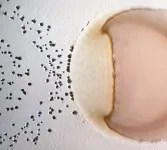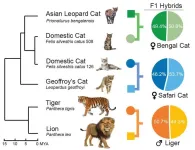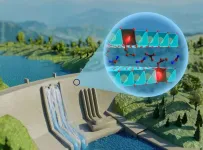When conditions cool down, a bacterial prey species becomes the predator
New study demonstrates that environmental changes can flip microbial predator-prey hierarchy
2024-01-23
(Press-News.org) In a new study, two species of bacteria grown in a lab reversed their predator-prey relationship after one species was grown at a lower temperature. Marie Vasse of MIVEGEC, France, and colleagues publish these findings January 23rd in the open access journal PLOS Biology.
Prior research has shown that ecological context can influence predator-prey relationships. For instance, similarity or contrast between background color and coloration of a prey species can influence how easily it is detected by predators. In addition, predator-prey relationships can sometimes switch, as is the case for two crustacean species that mutually prey on each other, where a change in surrounding salinity reverses which species dominates. However, there are few other known examples of such switching in response to non-biological ecological changes.
Some bacteria prey on others, and ecological context can influence predation efficiency. Building on that knowledge, Vasse and colleagues conducted several laboratory experiments to test how temperature might influence the predator-prey relationship between the bacterial species Myxococcus xanthus and Pseudomonas fluorescens.
They found that, when P. fluorescens was grown in a dish at 32 degrees Celsius and then exposed to M. xanthus, M. xanthus acted as the predator and extensively killed P. fluorescens. However, after P. fluorescens was grown at 22 degrees Celsius, the predator-prey relationship switched, with P. fluorescens killing and obtaining nutrients from M. xanthus for its continued growth.
The researchers conducted further experiments to better understand the mechanism by which growth at chillier temperatures may have reversed the predator-prey roles. They homed in on a non-protein substance released by P. fluorescens that is lethal to M. xanthus, the production of which appears to be influenced by temperature.
The researchers say their findings suggest that many forms of microbe-microbe killing not traditionally associated with predation – the consumption of a killed organism by its killer – may in fact result in it. They also note that, in this study, the temperature at which P. fluorescens grew before meeting M. xanthus could determine which would be predator and which prey when the two species met later, highlighting the importance of considering historical context when evaluating present predator-prey relationships.
This study and follow-up research could aid understanding of both natural ecology and practical applications, such as optimizing the use of some microbes to control others.
The authors add, “We find it fascinating that a relatively small change in just one ecological factor can determine who kills and eats whom in microbial predation. We suspect that microbe-microbe killing results in predation far more often than has previously been appreciated.”
#####
In your coverage, please use this URL to provide access to the freely available paper in PLOS Biology: http://journals.plos.org/plosbiology/article?id=10.1371/journal.pbio.3002454
Citation: Vasse M, Fiegna F, Kriesel B, Velicer GJ (2024) Killer prey: Ecology reverses bacterial predation. PLoS Biol 22(1): e3002454. https://doi.org/10.1371/journal.pbio.3002454
Author Countries: France, Switzerland
Funding: This work was funded by Swiss National Science Foundation (SNSF) grants 31003A_160005 and 310030B_182830 to GJV. The funders had no role in study design, data collection and analysis, decision to publish, or preparation of the manuscript.
END
[Attachments] See images for this press release:

ELSE PRESS RELEASES FROM THIS DATE:
2024-01-23
Author Interview:
Why did you create this reporting guideline?
We created this reporting guideline because consensus methods are widely used to produce recommendations in research and patient care, and so it is important to be able to judge how well they were conducted and how relevant these results might be.
How did you go about this?
We assembled an international steering committee of clinicians, journal editors, guideline and consensus experts, publication professionals and patients to look at how ...
2024-01-23
A new study finds that very few patients diagnosed with type 2 diabetes are able to achieve normal blood glucose levels through weight loss alone. A team led by Andrea Luk of the Chinese University of Hong Kong, report these findings January 23rd in the open access journal PLOS Medicine.
Clinical trials suggest that people with type 2 diabetes can control their blood glucose levels without medication if they lose weight and keep it off. However, it is unknown how many patients can achieve remission through weight loss alone under real-world conditions. In the new study, researchers looked at 37,326 people in Hong Kong who were newly diagnosed with type 2 diabetes to see ...
2024-01-23
The Louis-Jeantet Foundation honors the Director at the Max Planck Institute (MPI) for Multidisciplinary Sciences for discovering a new kind of biological matter that acts as a highly selective barrier to control central transport pathways in the cell. He has made groundbreaking contributions to our understanding of the processes by which macromolecules are transported into and out of the cell nucleus, the foundation said. The prestigious award is endowed with 500,000 Swiss francs (around 537,000 euros).
Görlich studies how cells solve the logistical challenge of getting their ...
2024-01-23
CORVALLIS, Ore. – Ecologists have long known that standing dead trees, commonly referred to as snags, are an important habitat element for forest dwellers and act as a driver of biodiversity.
They’re so important that in some managed forests, snag creation is part of the conservation tool kit – i.e., crews sometimes convert a percentage of live trees into dead ones through techniques ranging from sawing off their tops to wounding their trunks to injecting them with disease-causing fungi.
Until now, however, key questions had remained unanswered: How well do any of those techniques actually work over the long term? ...
2024-01-23
NEW ORLEANS – Ochsner Health has been named the winner of five awards from Press Ganey, a globally recognized analytics company offering healthcare experience solutions and services.
These awards are part of Press Ganey’s annual ranking of the top hospitals and health systems in the country, according to performance in patient experience, employee experience, physician experience, clinical quality performance and consumer experience.
“We’re honored to be recognized by Press Ganey for our excellence and compassion in caring for ...
2024-01-23
Ozempic and other GLP1 agonists are associated with a reduced risk of developing cirrhosis and liver cancer in people with type 2 diabetes and chronic liver disease, according to a nationwide study from Karolinska Institutet in Sweden published in the journal Gut.
GLP1 agonists like Ozempic reduce blood sugar levels and are mainly used to treat type 2 diabetes. However, as the drug also reduces appetite, it is now increasingly used to treat obesity and has become a popular weight-loss drug.
Reduced risk of liver damage
Results from early clinical trials also suggest that GLP1 agonists may reduce the risk of liver damage. Therefore, researchers at ...
2024-01-23
DENVER/Jan. 23, 2024 – Morris Animal Foundation-funded researchers have delved into various cat species' entire DNA sequence (genome), uncovering novel perspectives on domestic and wild cat evolution. This new work highlights distinct genetic changes and will be a critical tool for researchers investigating feline diseases and characteristics.
This study, which led to the findings published in Nature Genetics, used cutting-edge genome sequencing and assembly technologies to generate a more comprehensive and complete cat genome assembly, providing fundamental information on the feline blueprint and aiding in advancements in feline medicine.
"This ...
2024-01-23
Emerging research suggests it may be easier to use fusion as a power source if liquid lithium is applied to the internal walls of the device housing the fusion plasma.
Plasma, the fourth state of matter, is a hot gas made of electrically charged particles. Scientists at the Department of Energy’s Princeton Plasma Physics Laboratory (PPPL) are working on solutions to efficiently harness the power of fusion to offer a cleaner alternative to fossil fuels, often using devices called tokamaks, which confine plasma using magnetic fields.
“The purpose of these devices is to confine the energy,” said Dennis Boyle, a staff research physicist ...
2024-01-23
Concrete is an essential material in the construction industry, where it is fundamental to the foundations and structures of dwellings and office buildings, as well as roads, dams and bridges, among many other infrastructure projects. However, the service life of concrete is limited, and it must be monitored in order to guarantee the safety of these structures. To facilitate fast, low-cost, in-situ analysis that dispenses with the need to take samples to a laboratory, researchers at the University of São Paulo’s Physics Institute (IF-USP) in Brazil, in collaboration with colleagues at the University of Leuven in Belgium, have developed a luminescent material that reveals the presence ...
2024-01-23
ITHACA, N.Y. -- An interdisciplinary collaboration used a cutting-edge form of RNA tagging to map the gene expression that occurs during follicle maturation and ovulation in mice.
The resulting atlas reveals a slew of previously unknown cellular and molecular interactions that drive ovulation, which is crucial for female fertility. The findings could prove pivotal for developing therapeutic treatments for infertility.
The research, published Jan. 22 in Proceedings of the National Academy of Sciences, was ...
LAST 30 PRESS RELEASES:
[Press-News.org] When conditions cool down, a bacterial prey species becomes the predator
New study demonstrates that environmental changes can flip microbial predator-prey hierarchy






